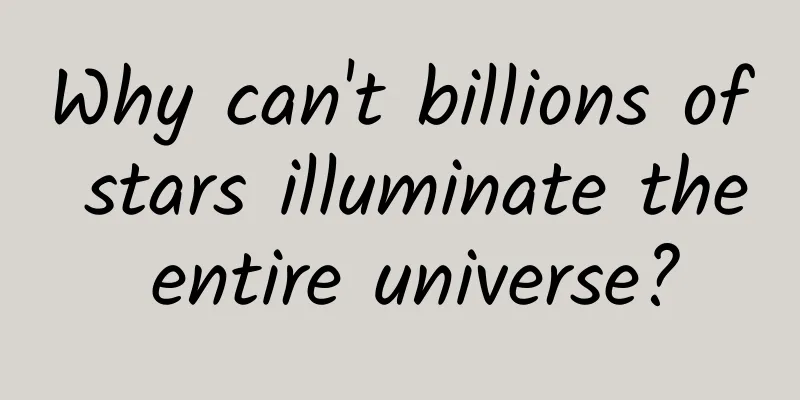Why can't billions of stars illuminate the entire universe?

|
This ancient problem is known as Olbers' paradox. Image credit: Graham Holtshausen on Unsplash The universe is full of stars, but why is the sky still dark? This question has puzzled mankind for a long time and has a special name: Olbers' paradox. Astronomers estimate that there are about 200 trillion trillion (2×10^23) stars in the observable universe, many of which are as bright as our sun or brighter. So why isn't space filled with dazzling starlight? You might guess that this is because many stars in the universe are very far away from Earth. Of course, the farther away a star is from Earth, the dimmer it will appear, with a star that is 10 times farther away appearing 100 times dimmer. But it turns out that's not the whole answer. Imagine a bubble Assuming the universe is very old, the light from even the most distant stars has had enough time to reach Earth. In this hypothetical scenario, all the stars in the universe would not be moving. Imagine a large bubble with the Earth at the center. If this bubble is about 10 light-years in diameter, it will contain a dozen stars. Of course, at a distance of several light-years, many of these stars will appear very dim from Earth. If we continue to enlarge the diameter of this bubble to 1,000 light years, then to 1 million light years, and then to 1 billion light years, the farthest stars in the bubble will appear dimmer. However, in this increasingly large bubble, there will be more and more stars, all of which are shining. Although the farthest stars appear dimmer, their number will also be greater, and the entire night sky should appear very bright. After going around in a circle it seems we are back to the starting point, but in fact we are closer to the answer. Age issues In this bubble scenario, we assume that the stars don't move and that the universe is very old. However, the universe is only about 13 billion years old. James Webb Space Telescope image of the massive galaxy cluster WHL0137-08, which contains the most magnified galaxy known from the first billion years of the universe, Sunrise Arc, and the most distant star ever detected in that galaxy, Earendel. Earendel's light took 12.9 billion years to reach Earth, meaning it was shining within the first billion years of the universe's formation. Image credit: NASA, ESA, CSA, D. Coe (STScI/AURA for ESA; Johns Hopkins University), B. Welch (NASA's Goddard Space Flight Center; University of Maryland, College Park) Image processing: Z. Levay Although this is an extremely long time from a human perspective, it is very short from an astronomical perspective, so short that the light from stars more than 13 billion light-years away has not actually reached Earth yet. Therefore, the actual bubble around Earth that contains all the stars we can see only extends to about 13 billion light-years from Earth. There aren't enough stars in the bubble to fill every line of sight. Sure, if you look in some directions of the sky, you'll see stars, but if you look in some other parts of the sky, you won't see any stars. That's because in those dark places, the stars that might appear on your line of sight are too far away for their light to reach Earth yet. As time goes by, the light from these increasingly distant stars will have enough time to reach us. Doppler shift You might ask, will the night sky eventually light up completely? But this goes back to another thing we assumed at the beginning: that all the stars are not moving. But in fact the universe is expanding, and the most distant galaxies are moving away from the earth at almost the speed of light. Because galaxies move so fast, the light from stars shifts to colors that the human eye can't see, an effect called Doppler shift. So even if the light has enough time to reach you, your eyes still can't see the light from the most distant stars, and the night sky won't be fully illuminated. Doppler shift, also known as redshift, refers to the light emitted from an object far away from the observer being more biased towards the red end of the spectrum, that is, the wavelength becomes longer and the frequency decreases. If you wait longer, the stars will eventually burn out, and stars like the sun can only last about 10 billion years. Astronomers assume that in the distant future, 100 trillion years from now, the universe will fall into darkness, with only stellar remnants such as white dwarfs and black holes inhabiting it. NASA Enthusiasts Although our night sky isn't completely filled with stars, we live in a very special period in the life of the universe, and we are fortunate to enjoy a gorgeous and complex night sky, where light and darkness coexist. |
>>: Families, those who like flat-faced puppies are in luck
Recommend
JD.com 618 Post-Battle Review: A Textbook Marketing Case
This year's 618 Mid-Year Shopping Festival fi...
China Passenger Car Association: Pickup Truck Manufacturers Wholesale Sales Ranking in May 2024
In May 2024, the pickup truck market sold 45,000 ...
How would life change if the Earth was flat?
A flat Earth would look very different from space...
The natural "carpet" of the Qinghai-Tibet Plateau has been renewed! Scientists have discovered 11 new species of lichens
The Qinghai-Tibet Plateau has an average altitude...
How to create a Zhuhai food ordering app? How much does it cost to develop a food ordering app?
The catering industry has become the first choice...
Did you watch Papi Jiang yesterday? Lirenlijuan’s 22 million RMB advertisement is finally here!
At six o'clock yesterday evening, Papi Jiang ...
Why are all the Chang'e series satellites launched from the Xichang Satellite Launch Center?
There is a small city called Xichang in the south...
Teach you how to make money with Douyin from scratch - techniques to attract fans and monetize
Tik Tok - the second wave of short video populari...
KPMG: Global Finance Adoption of AI Report
KPMG’s report shows that despite investments acro...
The establishment of the fourth operator of the State Grid may promote the development of 4K TV
In recent years, there have been more news report...
Moles can also become cancerous! Check out if your mole is dangerous →
Everyone has some moles on their body. Most moles...
When buying a TV during the 618 Shopping Festival, should you choose LCD, OLED or Mini LED? Learn their advantages and disadvantages in one article!
Are OLED TVs still okay? In early May this year, ...
Shanghai has 1 new confirmed case imported from the United States! What is the specific situation? Also attached is the latest national epidemic situation!
Currently, the United States is the country with ...
How to make an event planning plan? Event planning skills!
Activities are a means to quickly achieve specifi...









